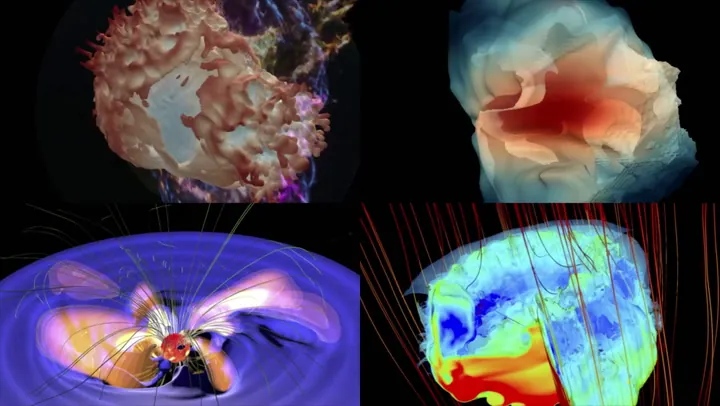
Explore Cosmic Wonders: 3D-Print Your Own Supernova Remnants with NASA's Chandra Data
2025-05-07
Author: Chun
Ever wanted to hold a piece of the universe in your hands? With NASA's groundbreaking new models derived from the Chandra X-ray Observatory, you can now do just that! Using advanced theoretical models and detailed data, scientists have crafted stunning 3D representations of celestial phenomena that are not only visually arresting but also 3D-printable!
Situated more than a third of the way to the moon, the Chandra Observatory is the world’s most powerful X-ray telescope, revolutionizing our understanding of extreme cosmic environments since its launch in 1999. Its vivid imagery unveils the dramatic remnants of exploded stars and the fiery gases swirling around black holes, revealing more about the universe's chaotic beauty.
However, while these images are breathtaking, they often come as flat snapshots that fail to convey the true complexity of cosmic structures. Enter the new age of 3D modeling! Researchers are transforming these images into immersive, tangible forms, allowing curious minds—be they students, educators, or the visually impaired—to experience cosmic phenomena like never before. Imagine feeling the contours of a supernova remnant or holding a black hole’s environment in your hands!
Unveiling the Celestial Models
Four sensational new 3D models are now available: Cassiopeia A (Cas A), G292.0+1.8, the Cygnus Loop, and the star BP Tau. Each model provides a unique and physical glimpse into the universe, allowing anyone to explore the magnificent structures from multiple angles.
The Mysteries of Cassiopeia A
In the constellation Cassiopeia, scientists have unearthed a peculiar feature known as the "Green Monster." This enigmatic green structure emits powerful infrared radiation, leaving astronomers baffled about its origins. Early studies using Chandra's data suggest it may be the remnant of a supernova blast wave interacting with surrounding gas and dust, creating its captivating green glow.
The Young Star BP Tau
The 3D model of BP Tau represents a young star just a few million years old, still in its formative phase. It is enveloped by a rotating disk of gas and dust, typical for stellar development. The dynamic interactions highlighted in this model showcase dramatic flares—intense bursts of energy—triggered by this young star, illuminating the star's growth and the vital processes shaping its environment.
A Journey Through the Cygnus Loop
The Cygnus Loop, or the Veil Nebula, is an exquisite remnant from a massive star's explosive demise, located about 2,000 light-years away. This nebula is born from a supernova that occurred approximately 10,000 to 20,000 years ago. Its intricate network of expanding gases provides astronomers with a glimpse into the dynamic cycles of stellar life and death, showcasing how the catastrophic end of a star gives rise to breathtaking cosmic structures.
Exploring G292.0+1.8
G292.0+1.8 stands out as a relatively young supernova remnant positioned around 20,000 light-years away in Centaurus. It showcases a spectacular blend of synchrotron radiation and heavy elements like oxygen, sulfur, and iron. At its heart lies a rapidly spinning neutron star emitting X-rays, offering critical insights into stellar lifecycles and the explosive aftermath of supernovae. This intricate remnant is a treasure trove for scientists aiming to decipher the complexities of cosmic explosions.
These revolutionary 3D models not only pave the way for enhanced academic engagement but also open an electrifying realm for enthusiasts to explore and appreciate the wonders of the universe from the comfort of home. So, are you ready to embark on your cosmic journey?




 Brasil (PT)
Brasil (PT)
 Canada (EN)
Canada (EN)
 Chile (ES)
Chile (ES)
 Česko (CS)
Česko (CS)
 대한민국 (KO)
대한민국 (KO)
 España (ES)
España (ES)
 France (FR)
France (FR)
 Hong Kong (EN)
Hong Kong (EN)
 Italia (IT)
Italia (IT)
 日本 (JA)
日本 (JA)
 Magyarország (HU)
Magyarország (HU)
 Norge (NO)
Norge (NO)
 Polska (PL)
Polska (PL)
 Schweiz (DE)
Schweiz (DE)
 Singapore (EN)
Singapore (EN)
 Sverige (SV)
Sverige (SV)
 Suomi (FI)
Suomi (FI)
 Türkiye (TR)
Türkiye (TR)
 الإمارات العربية المتحدة (AR)
الإمارات العربية المتحدة (AR)